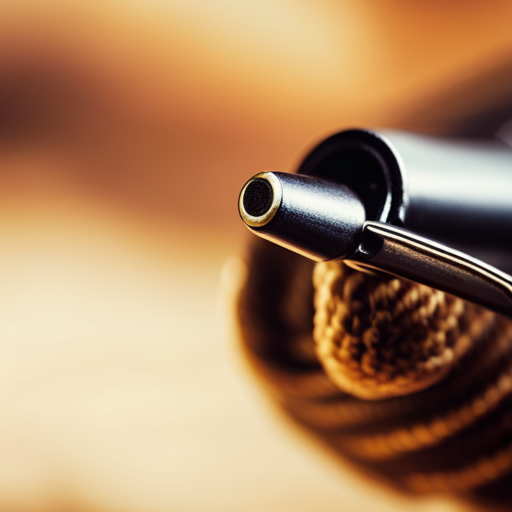As anglers, we are constantly seeking the perfect blend of materials to craft topwater fly patterns that entice even the most selective fish. Selecting the right foam is a crucial element in creating effective and durable flies.
In this article, we will delve into the characteristics of foam, explore the various types suitable for topwater flies, and provide expert insights on determining the most suitable foam for your target species.
Understanding Foam Characteristics
Understanding foam characteristics is crucial for selecting the right material when tying topwater fly patterns. Two key characteristics to consider are foam buoyancy and foam density.
Foam buoyancy is essential for keeping the fly afloat and providing the necessary support for the topwater presentation. It is imperative to choose foam that offers high buoyancy to ensure the fly sits high on the water surface, increasing its visibility to the fish.
Additionally, foam density plays a significant role in determining the durability and buoyancy of the fly. Lower density foam is preferred as it provides better flotation, allowing the fly to stay on the surface longer. This is important for creating a realistic and enticing presentation to attract fish.
Understanding these foam characteristics will enable fly tyers to make informed decisions when selecting the appropriate foam for their topwater fly patterns. By carefully considering foam buoyancy and foam density, fly tyers can create effective topwater flies that perform exceptionally well on the water.
Types of Foam for Topwater Flies
Foam selection for topwater fly patterns is influenced by the characteristics of buoyancy and density discussed previously. When considering foam types for topwater flies, foam density plays a critical role in determining the effectiveness of the fly.
Closed-cell foam, such as EVA foam, is a popular choice due to its low density, which allows for excellent buoyancy properties. This type of foam is ideal for creating high-floating topwater flies that can support larger and heavier fly patterns.
On the other hand, open-cell foam, like that used in craft foam sheets, offers different buoyancy properties. It has a higher density compared to closed-cell foam, which can result in lower buoyancy. However, open-cell foam is advantageous for creating more compact topwater fly patterns that sit lower on the water’s surface.
Understanding the foam density and buoyancy properties of different foam types is crucial for selecting the right material to achieve the desired floating behavior for specific topwater fly patterns.
Factors to Consider When Choosing Foam
When choosing foam for topwater fly patterns, it is essential to consider factors such as buoyancy, density, and material properties.
-
Foam buoyancy: The foam’s ability to stay afloat is crucial for topwater flies. Look for foam that provides sufficient buoyancy to support the weight of the fly and any added materials without sinking.
-
Durability: Opt for foam that can withstand repeated strikes from aggressive fish without losing its buoyancy or shape. This ensures that your topwater fly patterns remain effective and durable over time.
-
Color options, texture variations: Consider foam that comes in a variety of colors and textures. This allows you to customize your topwater fly patterns to match specific prey species or to create patterns that stand out and attract the attention of fish.
When choosing foam for topwater fly patterns, these factors play a critical role in the effectiveness and durability of the flies.
Once the appropriate foam is selected, the next step is to explore foam preparation and application techniques.
Foam Preparation and Application Techniques
Effective foam preparation and application techniques are crucial for ensuring the durability and performance of topwater fly patterns. This includes considering buoyancy and color options. Foam shaping is a critical aspect of preparing foam for topwater fly patterns. It involves cutting, shaving, and sculpting the foam to achieve the desired shape and size for the fly pattern being created. Precision and attention to detail are necessary to ensure that the foam retains its buoyancy and contributes to the overall effectiveness of the fly pattern.
When it comes to application techniques, fly tying methods play a significant role in incorporating foam into topwater fly patterns. Properly securing the foam to the fly hook using techniques such as stacking, layering, or wrapping is essential for creating durable and aesthetically pleasing fly patterns. Incorporating foam with other fly tying materials such as feathers, fur, and synthetic materials also requires careful consideration to maintain balance and functionality in the finished fly pattern.
Tips for Matching Foam to Target Species
Choosing the appropriate foam for matching topwater fly patterns to target species requires careful consideration of the specific characteristics and behaviors of the intended quarry. Foam buoyancy plays a crucial role in determining the effectiveness of a topwater fly pattern, as it influences how the fly sits on the water and how it moves when retrieved.
When selecting foam for topwater flies, consider the following tips for matching foam to target species:
-
Research the Target Species: Understanding the feeding habits and behavior of the target species is essential. Different fish species have varying responses to topwater flies. Some may prefer a subtle presentation, while others may be attracted to more buoyant and visible patterns.
-
Experiment with Different Foam Densities: Adjusting the density of the foam can significantly impact the fly’s buoyancy. Experiment with different foam densities to achieve the desired floatation and movement that best mimics the natural prey of the target species.
-
Utilize Effective Fly Tying Techniques: Incorporating proper fly tying techniques, such as trimming the foam to create realistic shapes and profiles, can enhance the overall effectiveness of the topwater fly pattern. Pay attention to details like foam placement and trimming to ensure the fly behaves authentically on the water’s surface.
Frequently Asked Questions
Can Different Colors of Foam Affect the Success of Topwater Fly Patterns?
The color of foam can impact the success of topwater fly patterns by influencing fish attraction. However, foam density, environmental impact, and water conditions also play crucial roles in determining the effectiveness of different foam colors.
Are There Any Environmental Concerns With Using Certain Types of Foam for Topwater Flies?
When considering the environmental impact of foam for topwater fly patterns, it’s crucial to explore alternative materials. Assessing foam production and waste management can aid in selecting eco-friendly options, ensuring sustainable angling practices.
How Does the Density of Foam Affect the Performance of Topwater Fly Patterns?
The density of foam significantly impacts the performance of topwater fly patterns. It influences buoyancy, affecting the fly’s ability to stay afloat and maintain a natural presentation. Understanding this relationship is crucial for achieving optimal fishing success.
What Are Some Common Mistakes to Avoid When Preparing and Applying Foam to Topwater Flies?
When preparing and applying foam to topwater flies, common mistakes to avoid include improper foam selection, excessive glue application, and uneven foam trimming. These can affect buoyancy, casting, and lure action. Professional application techniques are crucial.
Can Foam Be Used in Combination With Other Materials to Create More Realistic Topwater Fly Patterns?
Combining materials in topwater fly patterns can enhance realism and success. Foam, when used in conjunction with other materials, can mimic natural movements and appearances, making the fly more enticing to fish. Selecting foam colors strategically contributes to this effect.
Conclusion
The selection of the right foam for topwater fly patterns is crucial for successful fly fishing. Understanding foam characteristics, considering factors such as buoyancy and durability, and applying proper preparation and application techniques are essential in creating effective topwater flies.
By matching the foam to the target species, anglers can improve their chances of a successful catch. Just like selecting the perfect tool for a specific job, choosing the right foam for topwater flies is key to achieving desired results.




